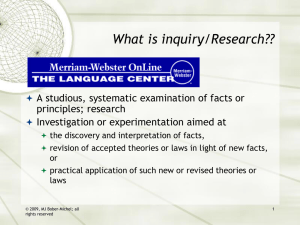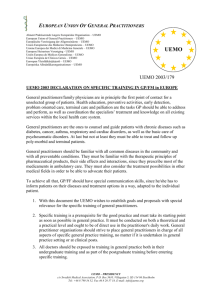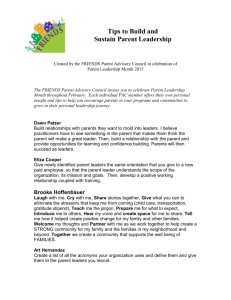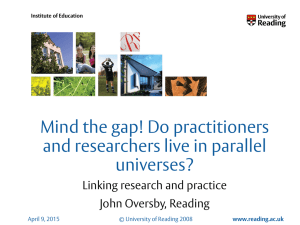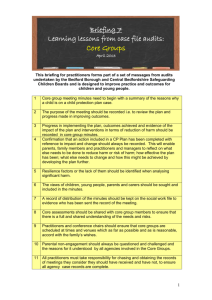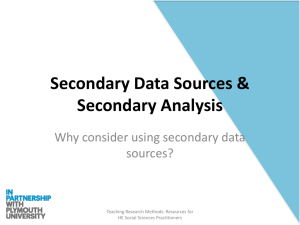The ESRC Teaching and Learning Research Programme is
advertisement
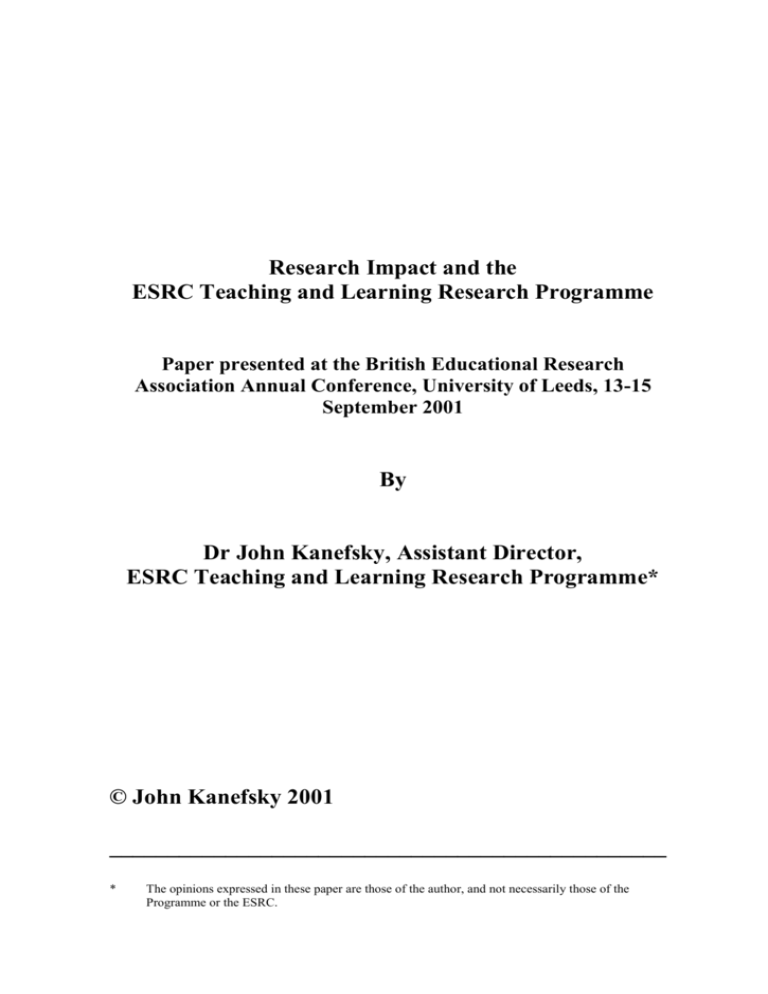
Research Impact and the ESRC Teaching and Learning Research Programme Paper presented at the British Educational Research Association Annual Conference, University of Leeds, 13-15 September 2001 By Dr John Kanefsky, Assistant Director, ESRC Teaching and Learning Research Programme* © John Kanefsky 2001 ________________________________________________ * The opinions expressed in these paper are those of the author, and not necessarily those of the Programme or the ESRC. 2 Research Impact and the ESRC Teaching and Learning Research Programme Introduction The ESRC Teaching and Learning Research Programme is not merely a series of thematically linked research projects. It has broader objectives centring on enhancing the achievement of learners of all types. To deliver these objectives we must maximise Programme-wide long term influence on research, policy and practice. All our activities are designed with that in mind. We have therefore been seeking to develop our understanding of what "impact" from our research means and how it can be achieved. As part of that effort we have organised over the last year a number of invitation seminars with mixed groups of practitioners, policymakers and researchers to explore these issues. We have also met with key partner organisations and a wide range of individuals; contributed to various other forums on related issues; and discussed the issues extensively within the Programme. This paper draws on the advice we have received and from a range of written sources to examine the concept of "impact" in relation to research (in both the Programme and the wider teaching and learning community); the conditions which promote and inhibit widespread take-up of research findings; and what we can do to ensure that impact is maximised over the life of the Programme and beyond. Its focus is principally but not exclusively on the influence of the conduct, transformation and communication of research, rather than on the commissioning and evaluation processes. We recognise of course that many of the challenges we face are universal rather than especially TLRP issues. We have therefore also looked to the contributions of “interactive social science”1 and the work done in other social science fields for ideas and inspiration. In reviewing the literature on effective impact we have further explored whether concepts and analytical frameworks from other disciplines (particularly medicine, business and technology) provide helpful comparators for considering how good practice in learning and teaching can be applied widely. 2 The Challenge Part of the context for the establishment of the Programme was recent criticism of the record of impact from research (by Hargreaves, Tooley, Hillage and others). They characterised evidence-led development of policy and practice in education and training as the exception rather than the norm. The reasons for this are complex, however, and it is in our view unhelpful to criticise any group, whether it be the researchers, the policy makers or the practitioners, for the paucity of impact from previous research. It seems to us much more productive to work together, to agree what impact we are seeking and then to be proactive in creating the conditions for it to be delivered. This is, of course, not a simple matter. Discussion in seminars, with partner organisations and within the Programme confirms that impact is problematical both conceptually and in practice for the whole research community, for a number of reasons: The world of teaching and learning is very complex. Producing high quality research is our wellspring for maximising impact, but this is not necessarily the main factor in practitioner take-up. Research (especially research programmes) does not operate in a vacuum and is always competing for the attention of the potential audiences. Generalising from the immediate research setting across varied teaching settings is difficult for researchers, change agents and policy makers alike. Large numbers of practitioners and their managers also have to consider whether the ideas and findings in question would work in their particulars circumstances. Persuading individuals to change ways of working is not easy, even if they are sympathetic to the desirability of doing so and have a sense of shared ownership of the research process and products. The Programme has three broad groups of audiences: the practice community; policy makers; and the research community. All are vital to us, but they are very different. For impact to take place, the messages from the Programme and its research have to reach all three groups - and be ones they want or can be persuaded to make priorities. Practitioners especially have many other pressing calls on their time, and are 3 influenced by managers, gatekeepers such as LEAs, regulatory systems and professional bodies more readily than by research evidence. The perception that research is mainly a top-down activity of little relevance to practice is still prevalent among practitioners in both formal education and in work- and community-based learning. There are hopeful signs that both the reality and the perception are evolving in positive directions, but research must demonstrate its value. Engaging and sustaining the commitment of the widest possible range of partners, and developing with them interactive and effective communication to generate influence, is difficult and resource-intensive (in both money and people). It requires Programmewide and system-wide infrastructure to support impact (allies, skills, reputation and assets) and our resources are limited. We have to prioritise effort, concentrating on key organisations which have high leverage. Policy makers and managers tend to look for well-packaged solutions for defined problems, while research realities are more messy. They work in very different contexts and to different timescales from the research community. They are also likely to be less receptive to research if it does not support the policy direction desired, refutes commonly held views or does not offer succinct, clear-cut advice. Many individuals, professional organisations and the media are interested in any conceptual and methodological tools we produce. However, what they want most is the research conclusions, recommendations and teaching materials of individual projects which they can apply or adapt to their own circumstances. These will not be available until 2003 (Phase I) and 2004-5 (Phase II). Impact at the broader Programme level - developing systemic capacity in the research community, influencing policy and managerial and accountability structures, creating a more research-engaged environment in the practice communities from schools to third age learning - is a longer term process, less easily defined and measured. 4 There is a delicate balance between proactively communicating what the Programme can offer and neither raising expectations which cannot be met nor over-claiming what can be delivered. There is pressure on researchers (from e.g. the RAE, funding timetables, career paths) to focus on their specific research tasks including writing formal research reports and professional papers. The impulse is then to move on to new projects, rather than working to embed current and previous research evidence into policy and practice and to share their experiences with their peers. However, the Programme has substantial and powerful assets which we will work in favour of early and prolonged impact, if we can mobilise and deploy them effectively. The following were the most frequently mentioned strengths by those who commented on the Programme's context: the quality of our researchers and projects - over 100 full and part time researchers plus a larger number of practitioner partners and policy advisers in 15 top-class teams. The Programme's independence, reputation and positional status, which gives us a voice and credibility with key decision making bodies and individuals - "speaking truth to power". Our ability to offer a wide range of other assets beyond the research projects: research reviews, conceptual and methodological developments, policy inputs, emerging findings, capacity building, interaction with a wide range of social science views. the networks of communication and influence residing in partner organisations such as BERA, TTA, CIPD, LSDA. They have stressed that they share much of the long term vision embodied in the Programme, and also want to engage with the process of putting research evidence at the forefront of the day to day operational context of teachers, trainers and other practitioners. However, with so many groups active in the field coordination is complex and time-consuming. 5 the support throughout the research, teaching and learning communities for the objective of making the best possible use of research evidence, and the hunger for reliable evidence from many sections of those communities. The Programme's determination to inject rigour into our approach to transformation and impact, drawing on the work already done in developing concepts and methodologies in our field. the backing of the ESRC, our funders and the Programme Steering Committee. Conceptualising "Impact" We have not found an entirely satisfactory definition of research "impact" anywhere in the literature, whether from within the field of education or from other disciplines. Even the term itself is questioned by some, as to them it implies abrupt action not collaborative processes of influence. Perhaps the least unsatisfactory definition is that of the NERF subgroup report on impact (2000), which characterises impact as “the influence or effect that educational research has on its audiences”2. However it is defined, "impact" clearly means something more that dissemination, which we define as a much more limited concept referring to the spreading of awareness by written and oral means, which may have no discernable impact on policy or practice, much less any contribution to raising the attainment of learners. And it is too linear and topdown: pull as well as push factors are involved. Engagement with the views of the recipient of the communication needs to be more centre-stage. Dissemination is necessary but not sufficient for impact; it is use of the knowledge that matters, not awareness of it. And of course, it must also be the right knowledge: we take this to be high quality research evidence, transformed and communicated to the right people. Impact for us is also more than the limited direct influence of a research project and report. This will of course contribute in its own right to better understanding of an issue among fellow researchers and some others. It may contribute to theory development, new research methods and metrics. So influence on the research community may be strong. It 6 will also generate enhancements in practice within and it is hoped a little beyond those practitioners directly engaged with the research. Such impacts are of course vital, the first stage of maximising take-up, since without them there is nothing to substantiate a case for wider impact. But they are not necessarily sufficient to convince other potential adopters. The fruits of research may, moreover, be impacts on policy, conceptual thinking, management or processes, or a combination of these, including the promotion of openness to new ideas and change as well as more direct influences. These impacts all support research take-up by individual practitioners and its routinisation in practice. The clear advice we have received is that the Programme must pursue all types of influence throughout its life. We therefore characterise impact as comprehending the whole research agenda and process, but with special emphasis on transforming research knowledge into worthwhile and new approaches and useful products – artefacts, teaching materials, improved policies, improved practice, new research approaches and techniques. It also means ensuring that as many of the potential beneficiaries as possible in all our audience groups are aware of these products and apply them to their circumstances as they judge appropriate. All those we have engaged with stress that effective impact is not a simple linear flow (of research followed by transformation, dissemination of findings and adoption by practice and policy). It is and must be a much more iterative, collaborative exchange of information and views: research, transformation and communication with not on its intended beneficiaries in structured but flexible forms, and recognising the constraints on practitioners of access, time and incentive. We have tried to represent impact diagrammatically, on the lines of figures 1 and 2. Most seminar participants, however, thought that such diagrammatic representations of impact are of limited use if not actually unhelpful. They advised that if impact has to be represented diagrammatically it should be conceptualised principally as a set of iterative processes. The work done in other disciplines gives us some reassurance that we are on the right track. The concepts of “research user” and “service user” used elsewhere in the social 7 sciences are, however, tricky to conceptualise and apply in teaching and training. Much of the impact work by the Programme has to be focussed mainly on practitioners rather than learners (especially children) because of the numbers involved and the practical impossibility of engaging directly with them. Concerns were also expressed to us about the conceptual problems in relating other disciplines, particularly the medical / pharmaceutical model of "evidence-based medicine", to teaching and learning research, since healthcare settings usually focus on treatment rather than diagnosis and on one-to-one rather than one-to-many interactions. Education and training practitioners (and researchers) are typically working with multiple interactions, in the tens or hundreds. It is therefore argued that concepts of effective impact from other social science disciplines and healthcare should not be applied uncritically to teaching and learning. It is, for example, not easy to conduct the equivalent of clinical trials in complex learning settings. Further thought is needed here. It was also pointed out by seminar participants and others that that, conceptually and practically, it should not be assumed that the greatest insights arise only from “successful” research. "Unsuccessful" research can be just as valuable as findings which confirm the expectations of the research design. Well conducted studies which do not find evidence to support the assumptions on which they are predicated and conclude that no change could be justified, or which confirm that existing policies and practices are appropriate, may tell us just as much if not more about "what works" and how to secure best practice. Such findings are, however, likely to be particularly difficult to transform and communicate interactively with policy and practice communities. And the publication and reward systems for the research community - the RAE, peer review processes, policies of academic and practitioner journals, and policy makers overwhelmingly favour positive results. These pressures may distort research priorities into areas which are "fashionable", repeat previous work or do not address any important questions. Securing impact from such research is difficult. 8 What promotes Impact? The evidence base for "what works" in achieving impact in teaching is still limited, although growing as a result of recent studies in the UK and elsewhere3. The Programme is also contributing to this evidence base through literature reviews and discussion with projects and partner organisations. There is further an increasing body of evidence from other social sciences, particularly child health and social care, published by Barnardos and the Joseph Rowntree Foundation among others4, although the caveats noted above must be recognised. We are convinced that research must be presented in ways which encourage practitioners and policy makers to adopt its findings. The literature on the diffusion of ideas and innovations, most notably that of Rodgers (1995), The Diffusion of Innovations5, provides a particularly useful analytical framework for understanding how this can and should work. Rogers argues that the extent and pace of take-up of an innovation are determined by the judgement of individual and institutional adopters of its attributes. This judgement, however, takes place in a climate of uncertainty over whether the innovation is superior to previous practice. Potential adopters therefore need reliable information about the innovation, in terms of its: relative advantage (compared to alternative or previous systems) compatibility with other elements of the socio-cultural and operational context complexity / ease of understanding: is the knowledge explicit or tacit? trialability (potential for limited [and reversible] application) observability (how visible / well communicated the results are to potential adopters) All these are, moreover, mediated by the nature of the decision making unit (individual, collective or authority-led), its openness to new ideas and information, the communication channels involved (mass or personal), the social system, and the role of the innovator and/or change agents and opinion formers in promoting the innovation. 9 Intermediaries are crucial to broadening the take-up of research because they can bridge the gap between research and practice. Opinion leaders within practice and policy communities are important groups. They have vital roles, especially in persuading the unconvinced majority of their peers by validating and mediating the knowledge. By commending the research they help to overcome caution about the risks and effort required in adopting its recommendations. Change agents (such as the Programme Office and educational organisations) work proactively to expedite and widen impact. They try to create a demand for research by reducing suspicion, providing reassurance and assisting with appropriate summaries of information. They can act as bridges between researchers and teachers / trainers without necessarily being a member of either group. Both the NERF sub-group report (2000) and the Goodison Group (2001) stress the key role of such mediators. The latter argues that, especially in post-school learning, if research is to be effective its aim should be to align the product with the needs of the customer. They judge, however, that the process for managing the transfer of knowledge between the researcher, the practitioner and the policy-maker is insufficiently robust, and that a cadre of "fleet footed highly mobile knowledge managers" is needed6. Creating drivers for implementation from regulatory and accountability systems bodies such as Ofsted, the GTCs, NTOs and professional organisations - and line management is an important positive factor. If they actively promote research awareness and use, impact is likely to be much wider and deeper. Making good use of interim findings, methodological developments etc. to create and sustain research awareness and interest should be at the heart of a long term strategy of creating demand for research evidence. Proactive use of the internet and emailed briefings to key groups on emerging Programme themes and findings is likely to be a good use of resources. Project participation in relevant teacher / trainer conferences etc. now will also help prepare the ground for later take-up of findings. 10 Transforming research outcomes for different groups in the most effective way, with the right voice and through the most appropriate interlocutors, will also be critical to achieving the best possible results from available resources. Research reports for policy and practice audiences should be written jointly by researchers and the peers of the intended audience; projects should identify candidates early. Short case studies, in user-friendly formats and using terms which are widely understood, are the best means of gaining attention. However, there are no publications in education and training which fulfil the same role as the medical journals in getting summaries of research to practitioners. For schools research, the TES/THES cannot fill that gap, and the DfES "Teacher" magazine is regarded with suspicion. Communities of practice in post-formal education are even more fragmented; there are real difficulties in reaching groups of practitioners, let alone individuals. A shared sense of ownership is central to impact, therefore demonstrating practitioner involvement throughout the research is important. Sustained and equalvalue partnerships between researchers, institutions and practitioners are the ideal, but in reality different partners will be engaged with differing degrees of intensity at different times. This matters less if they are actively involved at the critical points, especially in communication and persuasion to their peers and near-peers. If research evidence can cascade effectively through good diffusion networks from involved practitioners to their less engaged colleagues and schools / workplaces impact will be more widespread. Opinion formers (as facilitators) and managers (as drivers) play key roles in maximising impact. Gatekeepers such as LEAs, professional bodies and HR managers often control access to such networks. What doesn't work and what inhibits Impact? A similarly broad and complex range of factors operate to make impact less likely. Some are simply the inverse of the positive influences outlined above. As well as issues around what is communicated and how, there are organisational and individual constraints. The following appear to us to be the most salient: 11 The clear view of the community is that while some research take-up may come from traditional dissemination via trickle-out effects of academic publication in books and journals, this is bound to be very limited and haphazard. It is well known that only other academics and a few other engaged in formulating policy routinely read educational monographs and journals, although teachers and trainers do support the principle of peer reviewing of research findings before publication. Most also agree that making research available on websites is not a route to automatic take-up. They are invaluable for signposting but should not be relied on as the key vehicle for impact, as they are at present too passive: it is not true that "if you build it, they will come". Perhaps their most valuable role will be making more detailed versions of practitioner and policy summaries of research findings readily accessible. The internet is becoming more proactive, but making this a reality will require substantial commitment of financial, people and management resources. We have thus far been cautious in pursuing media coverage, in advance of having research findings on which they can base reporting. It was counselled that the media should not be relied to deliver any coverage, let alone favourable reporting. Long term relationships with them needed to be carefully developed. Each Project should build links to particular journalists and other research mediators. Inertia among gatekeepers and others is a key factor. Opinion formers and managers play key roles in controlling and influencing attitudes. Gatekeepers such as LEAs, professional bodies and HR managers have to be persuaded to be champions of change. Good intelligence on the pressures on them would help the Programme smooth the path for research impact. The view was widely expressed that practitioners (especially but not exclusively school teachers and those who deliver work-based learning) need adequate time / space, funding and management support for continuous professional development if they are to be more research-aware and research-led. ”Initiative overload” is an issue for teachers and trainers in all sectors. Desforges (2000a, 12 2000b) itemises the demands of accountability, assessment, inspection, management and terms and conditions systems on teachers and trainers as indicators that research evidence has a hard job of fighting for their attention. Leicester (1999) also quotes seven “enemies” of research evidence: bureaucratic logic; financial `bottom line`; consensus; politics; civil service cultures; cynicism; and time constraints.7 We have already noted concerns that "unsuccessful" research tends to get crowded out. This can be categorised as "pro-innovation bias"8, the assumption that new ideas /processes are inherently desirable and preferable to older ones. This assumption has led to over-concentration on successful, linear adoption and downplaying the iterative and messy nature of much innovation. From the point of view of the analyst, it is easier and more congenial (and perhaps a better career path) to study success than failure or uncertainty. This leads to ignoring lessons from unsuccessful or partially adopted innovations. A related phenomenon is to blame the potential adopter for not being researchaware, rather than understanding why individuals or groups reject new ideas, delay consideration of adoption, or try out then discontinue them - all of which are often done for very sound reasons. Lack of visibility: the Programme is competing for attention with a wide range of other initiative which are being pushed at practitioners (especially but not exclusively in schools). Many of these competing calls on the time and interest of potential adopters are of much greater salience: demands of managers, bureaucratic requirements, inspection and accountability regimes, etc. Conclusions There is a consensus that generating effective influence on policy and practice from education is a very complex task which has to be a shared and interactive process between researchers and others. It is important to develop sound strategies for each project and the overall Programme which address the multiplicity of audiences and their characteristics. These involve a number of forces which we need to operate on or at least influence: 13 promotion, by researchers and change agents such as the Programme and educational organisations, of research evidence and research use; fostering demand from policy-makers and practitioners, who want reliable evidence on which to base their actions - both "whether to" and "how to"; facilitation by a range of mediators and opinion formers, especially change agents; control of access to resources and support for implementation by "gatekeepers", both individual and organisational; resistance and inertia by organisations and individuals who have few incentives or resources to be research-led, or who are not convinced of the merits of such an approach; time constraints and initiative overload. We conclude that our activity in addressing these complex influences in pursuit of making the Programme as effective as possible in maximising impact must be: Interactive and Constructive because researchers are just one set of participants among many. We need to work with a wide range of partners, to make the whole greater than the sum of the parts. Iterative, exchanging ideas with researchers, policy-makers and practitioners. The aim is to foster an environment where all can contribute and awareness / use of research evidence are routine and central to both policy and practice. Transformative because we need to get the best of both basic and more applied research into improved policy and practice. This means transforming research evidence into practical products - teaching materials, learner support systems and people resources, appropriate policies and frameworks, etc. 14 Customer focused and Distributed since without demand from practice and policy communities impact will inevitably be sub-optimal. The Programme and individual project must share ownership of the fruits of our work freely and welcome re-invention and adaptation provided this does not pervert the evidence, since this will lead to the maximum take-up by potential adopters. We are taking these forward in a range of ways: We are continuing to develop collaboration with our identified key partner organisations, and working with them to put into effect specific activities such as workshops and conferences. Targeted communication and other interaction is planned for each project designed to meet the needs of different groups, from those already engaged with the research to those who are not currently interested in (or even aware of) our work. We will keep other relevant organisations informed through newsletters, briefings, and the Programme website, and work with them more proactively on individual projects relevant to their interests and where this can have high leverage for wider impact. We will argue in policy forums for greater emphasis on research impact in the RAE, funding policies, research strategies etc. We are supporting our research teams and our capacity building network in refining communication to have a sharper focus on impact not just dissemination, especially Phase II projects which have individual Communication Plans. We are working with all our projects to develop conceptual and methodological tools and to generate interim reports which they are content to release, though inter alia a closed electronic discussion forum so they can discuss difficult issues in a safe environment. These can then be made more public when thinking is better developed and emerging research findings are on surer ground. 15 Many people suggested to us that that spending most of the funding on the conduct of the research is short sighted. Although we already spend 5% of our total resources on Programme-level communication work, as well as the communication and impact element of project budgets, it was argued that even greater support is needed deliver wide and deep impact. Our Steering Committee have responded by making substantial additional funding available to our projects for extra impact work. The extended life of the Programme to 2008 arising from the funding of Phase III, focusing on post-school learning, will give us more time to work for long term impact than previously thought. Phase III will also be developed in ways which reflect what we have learnt from the earlier phases. A research specification will be issued at the end of 2001. 16 ESRC Teaching and Learning Research Programme Figure 1 The programme, policy development and impact 17 ESRC Teaching and Learning Research Programme Figure 2 Likelihood of impact? 18 References: 1 Caswill, C. and Shove, E. (2000), "Introducing interactive social science", Science and Public Policy, Vol 27, June 2000, pp.154-7. (special issue on ISS) 2 NERF (2000), The impact of educational research on policy and practice: sub group report (http://www.nerf-uk.org/subgroups/impact.html) 3 E.g. Cordingley, P.A. et al (2000) Teacher Perspectives on the Accessibility and Usability of Research Outputs (paper to BERA Conference 2000); in the USA, National Research Council (1999) Improving Student Learning, (Washington DC, National Adademy Press); and in Australia DETYA (2001) "The Impact of Educational Research", reprinted in Research Intelligence, 76 (July 2001), pp. 17-25. 4 Hughes, M., McNeish, D., Newman, A., Roberts, H. and Darshan, S. (2000) What Works? Making Connections: Linking Research and Practice (London, Barnardos); Roberts, H. (2000) Making Connections (paper to Regard Conference); Davies, H., Nutley, S. and Smith, P. 2000) What Works? Evidence-based Policy and Practice in Public Services (Bristol, Policy Press). 5 Rogers, E.M. (1995), The Diffusion of Innovations (4th Edn., New York, Free Press). See also Spence, W.R. (1994), Innovation: The Communication of Change in Ideas, Practices and Products (London, Chapman and Hall); Valente, T. (1995), Network Models of the Diffusion of Innovations (New York, Hampton Press). A short summary of the key concepts is in Kanefsky, J. (2001) “Maximising "impact" - insights from research on the diffusion of innovations”, College Research, Autumn 2001, forthcoming. 6 NERF (2000); Goodison Group (2001) Research and Life-long Learning (Godalming, FEdS). 7 Desforges, C. (2000a) Transforming knowledge on learning into educational practice (paper to TLRP Conference, Leicester, November 2000); Desforges, C. (2000b), Knowledge transformation (paper to Learning and Skills Development Agency Conference 2000); Leicester, G. (1999) "The seven enemies of evidence-based policy", Public Money and Management, vol 19 no. 1, pp.5-7 8 Rogers (1995), Ch. 3

